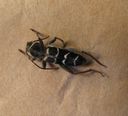Banded Ash Borer
Neoclytus caprea
Classification
- Phylum: Arthropoda
- Subphylum: Hexapoda
- Class: Insecta
- Order: Coleoptera
- Suborder: Polyphaga
- Superfamily: Chrysomeloidea
- Family: Cerambycidae
- Subfamily: Cerambycinae
- Tribe: Clytini
- Genus: Neoclytus
- Species: caprea
Pronunciation
How to pronounce Neoclytus caprea: /niːˈɒklaɪtəs ˈkæpriə/
These audio files are automatically generated. While they are not always 100% accurate, they are a good starting point.
Images

Summary
Neoclytus caprea, known as the banded ash borer, is a cerambycid beetle that primarily infests ash trees. It exhibits sexual dimorphism, one generation per year, and shows adaptations for flight and olfactory cues to navigate its environment and avoid interspecies competition.
Physical Characteristics
Adults range from 8-17 mm in length, with some recorded as large as 25 mm. Larvae can grow up to 22 mm. The species exhibits sexual dimorphism with females larger than males. Females have yellow and black banded elytra, while males have white and black banded elytra. Both sexes feature red-orange legs covered in white hairs.
Identification Tips
Look for elongated, narrow bodies with yellow and black stripes akin to wasps or hornets. Distinct band behind the heads helps distinguish from similar species.
Habitat
Typically found in the sapwood of ash, oak, and hickory, often emerging indoors from firewood.
Distribution
Native to North America, found throughout the continental United States except the Pacific coast, extends into eastern Canada.
Diet
Larvae feed on sapwood of ash trees during the summer; can also feed on hickory, elm, mesquite, and occasionally oak. Prefer seasoned wood over freshly felled or weakened trees.
Life Cycle
One generation per year. Adults emerge in early spring (March to June) to search for host plants to oviposit. Larvae bore into sapwood during summer and pupate in fall, emerging as adults in spring.
Reproduction
Females lay eggs in the bark of host plants, and larvae feed under the bark before entering the sapwood.
Tags
- beetle
- Cerambycidae
- Neoclytus caprea
- banded ash borer
- insects
- North America